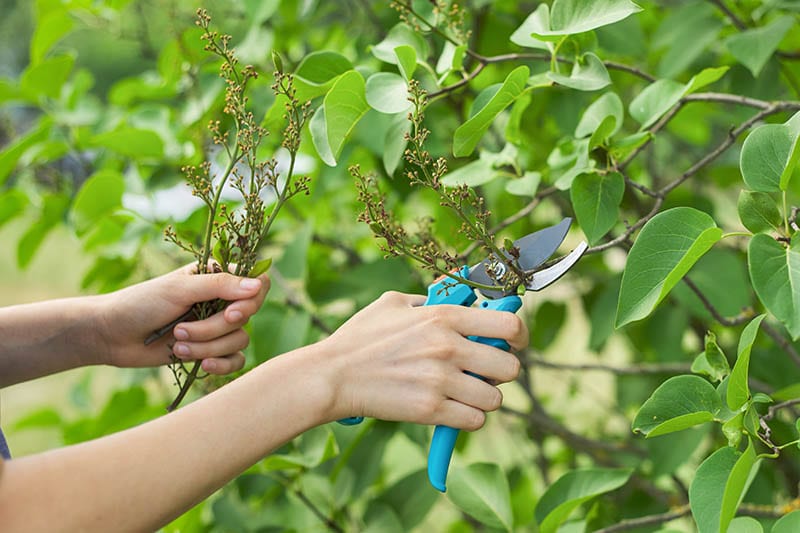When & How to Prune Lilacs: 5 Expert Tips
-
Kristin Hitchcock
- Last updated:

If you want your lilacs to stay healthy, it is vital that you prune them regularly. However, how and when you prune your lilac is essential to their health and you must do it correctly. Otherwise, you may damage your plant or not prune it sufficiently enough.
Luckily, lilacs are pretty forgiving. Therefore, with just a bit of background knowledge, you can easily prune your plant like a professional. Here are some of our top tips to help you get started.
The 5 Tips on When and How to Prune Lilacs
1. Prune After Flowering
Firstly, you should prune your lilacs right after they flower in the spring. Lilacs begin to create next year’s blooms right after the current year’s blooms fade. Therefore, if you wait too long to prune, you could be cutting off the following year’s blooms (which would lead to a very sad lilac). Instead, you want to trim right after the old flowers die but without giving the plant enough time to start developing new blooms.
2. Prune for Maintenance

You should prune your lilacs for maintenance yearly. You don’t want the lilacs to outgrow their space, or they may stop producing flowers. You’ll also need to remove any dead or broken stems to allow for new growth. Just letting your lilac go could lead to it getting quite scruffy.
Remove spent flowers as soon as they fade to encourage clean growth and appearance. You don’t want the dead flowers rotting on the stem, and the old growth can prevent new growth from forming. Do this with a good pair of hand pruners to aim each cut properly.
3. Prune for Rejuvenation
While you should maintain pruning every year, there may be times when you need to prune for rejuvenation. Missing a year (or more) may lead to this, for instance. Luckily, lilac bushes can be cut back a bit to help return them to their former glory.
Often, when these bushes are allowed to grow very high, they may appear to stop blooming. However, what happens is that only the tops of the plant bloom where it experiences the most sunlight. If it is taller than the average person, we may never see these blooms. We just get to stare at the stems.
To prevent this (or stop it), remove all the canes over 2 inches in diameter. You don’t have to measure them, but get as close as possible. However, don’t remove them all at once. Instead, remove 1/3 of the older stems each year for three years. This allows the plant to switch back to a fuller shrub.
You can just remove all of the older growths at once. However, take extra care of the plant if you decide to go this route. It isn’t great for the health of the plant, however.
4. Remove “Suckers”

A sucker is a new branch shooting up a few feet away from your plant. Technically, this is a new plant, despite actually being a part of the older plant. These will form completely new bushes if they aren’t removed. Therefore, we highly recommend removing them unless you want new plants.
You can also dig up the stems and plant them elsewhere if they aren’t where you’d like them.
New stems can grow right next to your plant, too. We recommend leaving these, as they can extend the life of your plant. A healthy lilac plant is a mix of new and old growth.
5. Cut Stems Down to the Ground
When trimming a stem, trim it down to the ground. However, when you’re just doing maintenance pruning, this isn’t necessary. You should only trim off the older flowers. However, if you’re doing major pruning or getting rid of suckers, be sure to prune to the ground. You don’t have to remove the “roots” or anything.
Conclusion
Lilacs need to be pruned to grow appropriately. Otherwise, they will simply grow upwards and stop producing blooms all over. Instead, the blooms will just appear on the very top—above everyone’s head. Therefore, if you want to see the flowers on your bush, you should prune your lilac bush regularly.
Preferably, you should prune the lilac bush every year after the flowers fade. Trim off all of the spent flowers, being sure to leave any new growth. This new growth will be next year’s flowers, so don’t trim anything but the older flowers.
Related Read:
- 18 Companion Plants for Lilacs (With Pictures)
- 10 Tips on When and How to Prune Oak Trees (With Pictures)
Featured Image Credit: VH-studio, Shutterstock
Contents

